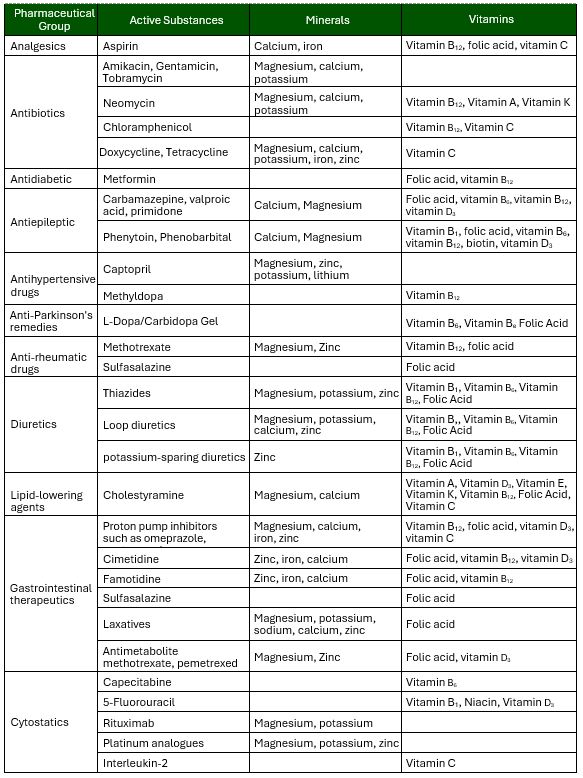When Drugs Lead to Biofactor Deficiency
For those in a hurry
Besides side effects and interactions, drugs can have a negative effect on the biofactor household. Seniors are particularly affected, they more easily exhibit malnutrition and frequently take drugs. Thiazide and loop diuretics, metformin, acid blockers and SSRIs are particularly problematic.
Many active ingredients in drugs can interfere with the absorption and excretion of vitamins, minerals or trace elements. The result is a biofactor deficit and an increased risk of further health disorders. In particular chronically ill and older patients must often take several drugs over a longer period of time, which can exacerbate a biofactor deficiency even further. Knowledge of these negative effects of pharmacotherapy on the supply of vitamins and minerals can therefore significantly improve holistic patient care.
Vitamins, minerals and trace elements are characterized in the organism by a variety of pharmacological effects. These biofactors steer numerous processes in the metabolism. They work as antioxidants, are involved in important enzyme reactions like for example the DNA and RNA polymerase or the sodium-potassium-ATPase, as well as in complicated endogenous systems such as bone formation, blood formation or nervous functions of both the central and also peripheral nervous systems. The body cannot produce the largest number of biofactors itself or not in sufficient quantities, so that these must be taken in from the outside through our diet. Furthermore, an increased supply of biofactors can be necessary for people at risk or with illnesses – at least over a certain interval. Life situations that increase the need for biofactors include for example growth, pregnancy and lactation, competitive sports, stress or chronic alcohol abuse.
Seniors, patients with chronic absorption disorders and chronically ill people like for example diabetics, cardiovascular patients or tumor patients are risk groups for a biofactor deficiency and demand even more attention in everyday practice. One of the reasons why these patient groups are emphasized are their often long term intake of drugs which worsen the biofactor balance. Mentioned here are widely used drugs like antibiotics, acid blockers, antidiabetics and lipid-lowering drugs
Drugs and Their Effect on the Biofactor Household
Interactions of active drug ingredients with other drug substances or essential vitamins, minerals and trace elements are then to be expected if the different active substances take the same absorption, transport and metabolism pathways. Therefore if patients must take drugs, there exists the basic possibility of interaction with the biofactor household. On the one hand the drug effect can be disturbed by vitamin or mineral substances. On the other hand – and this is what this article is about – the biofactor status can be negatively influenced by the active drug substances.1, 2 A decreased intestinal absorption and/or an increased excretion of biofactors through the bowel or kidney can occur.
However it not only depends on the active profile of the drug whether a biofactor deficiency comes up under pharmacotherapy, but also on the nutritional and biofactor status of the patients before the therapy and the duration of the drug treatment. The vitamin and mineral status of a healthy person, eats a well balanced diet and avoids stimulants, are usually not affected by a short drug therapy. Only under a long time therapy – even intensified by the intake of several drugs – can negative effects on the biofactor supply come up. Here again are emphasized chronically ill patients under long term care or continuous medication as well as multimorbid seniors.
Seniors – Increased Risk for a Biofactor Deficiency
Even without long term drug therapy seniors are considered to be one of the most important risk groups for a biofactor deficit. Numerous nursing home residents in Germany starting from 65 years are considered as malnourished according to the “Ernährung in stationären Einrichtungen für Senioren und Seniorinnen“ [Nutrition in inpatient facilties for seniors] (ErnSTES-Studie).3 According to the results of the nutrition report, only a third of the residents were found in good nutritional status, about half of the older people were classified as malnourished and 11% even as manifestly malnurished. Based on these data, it is not surprising that the supply of many biofactors in seniors is also suboptimal and clearly under the recommendations of the D-A-CH Society.4 The results of the Seneca and Bethany studies5, 6 on the nutritional and biofactor status of seniors, which have been known for more than 20 years, have been confirmed by current investigations.7-10
As potential causes for the biofactor deficit of many seniors are chewing and swallowing disorders, the reduced feeling of thirst and taste, absorption disorders due to a declining efficiency of the gastrointestinal tract, chronic illnesses and – with this we are at the main focus of this article – the mentioned numerous drug interactions. Pensioners take an average of 5.6 drugs, for residents of a nursing home this number rises to 9.3. For each additional drug taken the risk of hospitalization, nursing home admission and death increases to almost 9%.11 Besides the side effects of the drugs themselves and drug interactions, their negative influence on the biofactor household also plays a role. A vital deficit of vitamins, minerals and trace elements can have an effect namely as another possible risk factor for additional illnesses or exacerbate the already existing complaints and thus further worsen the health status of the patients. “Against the background of these relationships, the negative influence of drugs on the biofactor status should be given stronger consideration in daily practice,” Prof. Hans Georg Classen, Chairman of the Society for Biofactors warns in this context. And even if seniors should certainly be particularly emphasized, the problem of the effects of pharmacotherapy on the biofactor household also applies to other ages and patient groups (see table below) .
 Table 1: Frequently prescribed drugs (excerpt) that can increase the risk of biofactor deficiency.12
Table 1: Frequently prescribed drugs (excerpt) that can increase the risk of biofactor deficiency.12
Diuretics Can Become Biofactor Robbers
Let us take a closer look below at some of the drugs and their influence on the biofactor status. Diuretics for example rank among the more frequently prescribed drugs – in particular thiazide (such as hydrochlorothiazide), loop diuretics (i.e. furosemide) and potassium-sparing diuretics (e.g. triamterene, spironolactone) – used for essential hypertension, cardiac insufficiency and edema.
While representatives of the latter substance class not only have an effect on potassium-sparing, but also on magnesium-sparing, thiazide and loop diuretics lead to an increased renal excretion of both biofactors. Thereby the risk for magnesium and potassium deficits increases. Such a deficit plays an important role in the pathogenesis of essential hypertension, one of the indications for diuretic therapy. It thus becomes a “vicious circle” in which the heart and circulation are further burdened by magnesium and potassium deficiencies. Besides, diuretics from all three substance classes can flush further vital biofactors out of the body through increased urinary excretion. Above all vitamins B1, B6, B12 and folic acid as well as zinc are to be mentioned here. Diuretics with the active ingredient triamterene are folic acid antagonists and can additionally inhibit the effect of the vitamins in this way. This can lead to a deficiency in the mentioned biofactors with corresponding deficiency symptoms.13
Long term Metformin intake increases the risk for a Vitamin B12 deficiency.
Vitamin B12 Deficiency Under Metformin Therapy
With long term intake the oral antidiabetic metformin prescribed for diabetics increases the risk for a vitamin B12 deficiency. Studies show the following correlations:
- The risk of vitamin B12 deficiency in diabetics on metformin therapy is three times higher in comparison with non-diabetics14, 15 and twice as high in comparison with diabetics without metformin.16
- Patients who took metformin for more than 10 years suffered more often from vitamin B12 deficit than patients with shorter intake duration.17
In view of more than 7 million people in Germany with documented Type-2 diabetes18 and the resulting frequency of metformin prescription, numerous diabetics can come up with a vitamin B12 deficiency. With the highest possible evidence level A Biguanide metformin is considered the first choice if patients with Type-2 diabetes cannot manage their blood sugar with life style changes alone. Unlike the practice recommendations of the German Diabetes Society (DDG) the American Diabetes Association (ADA) explicitly recommends that vitamin B12 status should be controlled regularly under metformin therapy, particularly in patients with anemia or neuropathy.19
Thiazide and loop diuretics lead to an increased renal excretion of potassium and magnesium.
Acid Blockers are Vitamin B12 Robbers
Proton pump inhibitors are part of the most frequently prescribed drugs even though there are increasing numbers of indications of side effects such as nephritis,20 renal insufficiency 21 or an increased risk of dementia22 with long term intake. Acid blockers like pantoprazole, omeprazole or esomeprazole against heartburn, gastritis and other stomach diseases inhibit the activity of the parietal cells in the stomach. Parietal cells are known to produce stomach acid which the body additionally uses, among other things, to dissolve vitamin B12 from dietary protein. Additionally the parietal cells form the intrinsic factor necessary for vitamin B12 absorption. The result of an acid blocker therapy can therefore be a vitamin B12 deficit. Studies have proven that the risk for a vitamin B12 deficiency from long term therapy with H2 blockers increases about 25% and with proton pump inhibitors actually by about 65%.23
Additionally proton pump inhibitors lead to a significant degrading of vitamin C concentrations in the stomach juices. There vitamin C acts as an antioxidant and eliminates among other things potential carcinogenic substances (nitrites) in the saliva. Beyond that the intake of proton pump inhibitors possibly leads to reduced vitamin C blood levels (serum and plasma). The prolonged intake of proton pump inhibitors can have a negative influence on the status of vitamin D3 as well as the minerals magnesium and calcium and the trace elements iron and zinc.
Numerous active drug ingredients interfere with the vitamin D3 household.
These Drugs Can Influence the Vitamin D3 Status
It is known that numerous active drug ingredients intervene in the vitamin D3 household. A drug induced vitamin D3 deficiency can lead, among other things, to a secondary hyperparathyroidism and to disturbances of the bone mineralization even to osteoporosis.
With anticonvulsive drugs epilepsy patients have a two to six times higher risk of bone fractures than the normal population.24 With up to 50% of patients treated long term with antiepileptics an antiepileptic osteopathy is provable.25
With corticosteroids an osteopathy should be considered based on disturbances of the bone mineralization.
Likewise with corticosteroids an osteopathy is considered based on the disturbance of the bone mineralization. According to current scientific knowledge a safe corticosteroid dose below which there is no increased osteopathy risk does not exist.26 Even a daily dose under 2.5 mg of a prednisone equivalent over three months can increase the fracture risk. Thus the umbrella organization Osteology advises for patients with corticosteroid therapy to check the vitamin D3 status (Calcidiol = 25 OH-D3 in serum) by laboratory diagnosis and to compensate a deficiency by targeted supplementation.27
A significant linkage exists between the intake of selective serotonin reuptake inhibitors (SSRIs) and the risk for osteoporosis development. Selective serotonin reuptake inhibitors can increase the risk of fractures depending on dose and duration. They reduce the formation of osteoblasts and thus the formation of bone tissue during bone development and increase the formation of osteoclasts which dissolve the bone matrix collagen through special enzyme reactions. Thus with the intake of SSRIs we should keep a close eye on the endogenous status of the biofactors calcium, magnesium and vitamin D3. These biofactors are known to play an important role in bone metabolism. In particular women during and after menopause are affected by the negative influence of SSRIs on the bone metabolism. Even if meaningful studies on the protective effect of a supplementation with calcium, magnesium and vitamin D3 with SSRI therapy are currently pending, an accompanying intake of the mentioned biofactors would seem sensible based on the described connections.
Result
On account of the extensive interactions under treatment with the often prescribed drugs mentioned here, attention should regularly be paid to the biofactor status. The purposeful compensation of a biofactor deficit should accompany the necessary drug therapy in order to be able to positively influence the disease course and the development of secondary diseases.

An Exclusive Translated Article for P2P Supporters
From the Monthly Publications of P2P
Published November 2022
From an article in Naturheilpraxis, Volume 75, February 2022
Machine Translation by SYSTRAN, Lernout & Hauspie, LogoMedia & Promt
Translation & redaction by: Carolyn L. Winsor, P2P Consulting
© Copyright 2022, Naturheilpraxis, Dr. Daniela Birkelbach, Germany
You can find detailed information on the biofactors mentioned here and others, as well as for the areas of deficiency symptomatology, diagnosis and dosage recommendations on the website of the Society for Biofactors (www.gf-biofaktoren.de)
The Society for Biofactors is a non-profit association that pursues the goal of promoting the scientific basis of the therapy ad prophylaxis with biofactors.
Literature
- Mohn et al.: Evidence of Drug-Nutrient interactions with chronic use of commonly prescribed medications: An update. Pharmaceutics 2018,10: 36ff
- Samaras D et al.: Effects of widely used drugs on micronutrients: A story rarely told. Nutrition 2013, 29: 605-610
- Heseker H et al.: ErnSTES-Studie, in DGE: Ernährungsbericht 2008,157-204
- D-A-CH Referenzwerte für die Nährstoffzufuhr, 2. Auflage, Ausgabe 2015. n.rpv.media/37k
- Haller J at al.: Changes in the vitamin status of elderly Europeans: plasma vitamins A, E, B-6, B-12, folic acid and carotenoids. SENECA Eur J Clin Nutr 1996 Jul, 50 Suppl 2: 532-546
- Schlierf G et al.: Malnutrition in geriatric patients: the Bethanien nutritional study. Z Gerontol 1989 Jan-Feb, 22(1): 2-5
- Assis BS et al.: Micronutrient intake in elderly living in nursing homes. Nutr Hosp. 2018 Feb 13, 35(1): 59-64
- Vural Z et al: Trace mineral intake and deficiencies in older adults living in the community and institutions: A systematic review. Nutrients 2020 Apr 13, 12(4): 1072 if
- Zhen Liu et al: Dietary micronutrients intake status among Chinese elderly people living at home: Data from CNNHS 2010-2012. Nutrients 2019 Aug 2, 11(8): 1787
- Conzade R et al.: Prevalence and predictors of subclinical micronutrient deficiency in German older adults: Results from the Population-Based KORA-Age Study. Nutrients 2017 Nov 23, 9(12): 1276 ff
- Prim Hosp Care AlIg Inn Med. 2019,19(04): 113-115
- Gröber U: Arzneimittel und Mikronährstoffe. Stuttgart: Wissenschaftliche Verlagsgesellschaft mbH 2007
- Mangelsymptomatik der wichtigsten Biofaktoren siehe https://www.gf-biofaktoren.de/
- De Groot-Kamphuis DM et al.: Vitamin B12 deficiency and the lack of its consequences in type 2 diabetes patients using metformin. Neth J Med 2013 Sep, 71(7): 386-390
- Damiäo CP et al.: Prevalence of vitamin B12 deficiency in type 2 diabetic patients using metformin: a cross-sectional study. Sao Paulo Med J 2016 June 03, ISSN 1516-318
- Yang Wet al.: Associations between metformin use and vitamin B12 level, anemia and neuropathy in patients with diabetes: a meta-analysis. J Diabetes 2019 Sep, 11(9): 729-743
- Chapman et al.: Association between metformin and vitamin B12 deficiency in patients with type 2 diabetes: A systematic review and meta-analysis. Diabetes metab 2016 Apr 26
- Deutscher Gesundheitsbericht: Diabetes 2020. Herausgeber: Deutsche Diabetes Gesellschaft (DDG) und diabetes-DE – Deutsche Diabetes-Hilfe. Redaktion Diabetes-Journal, Mainz, 2020
- Chamberlain JJ et al.: Pharmacologic therapy for type 2 diabetes: Synopsis of the 2017 American Diabetes Association Standards of medical care in diabetes. An Intern Med 2017, 166(8): 572-578
- Antoniou T et al.: Proton pump inhibitors and the risk of acute kidney injury in older patients: a population-based cohort study. CMAJ Open 2015 Apr-Jun, 3(2): E166-E171
- Xie Y et al.: Proton pump inhibitors and risk of incident CKD and progression to ESRD. JASN 2016, 27(10): 3153-3163
- Gomm Wet al.: Association of proton pump inhibitors with risk of dementia: a pharmacoepidemiological claims data analysis. JAMA Neurol 2016 Apr, 73(4): 410-416
- Lam JR et al.: Proton pump inhibitor and histamine 2 receptor antagonist use and vitamin B12 deficiency. JAMA 2013 Dec, 310(22): 2435-2442
- Valsamis HA et al.: Antiepileptic drugs and bone metabolism. Nutr Metab 2006, 3(36):1-11
- Vestergaard P: Epilepsy, osteoporosis and fracture risk – a meta-analysis. Acta Neurol Scand 2005, 112(5): 277-286
- Kanis JA et al.: A meta-analysis of prior corticosteroid use and fracture risk. J Bone Miner Res 2004, 19(6): 893-899
- DVO-Leitlinie Glukokortikoidinduzierte Osteoporose, n.rpv.media/49p



